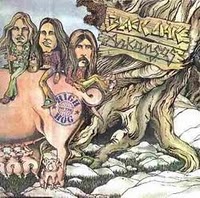 Clodhoppin’ rockers Black Oak Arkansas achieved their biggest success with High on the Hog and it’s obnoxious #25 single “Jim Dandy,” which featured raspy vocalist Jim “Dandy” Mangrum and Ruby Starr hootin’ it up like a pair of courtin’ cousins. Featuring a few other, similarly buck-toothed entries in “Happy Hooker,” and acoustic pickers “Back to the Land” and “High ‘n’ Dry,” High on the Hog is redeemed by the inclusion of nasty southern-livin’ rockers like the funky opener “Swimmin’ in Quicksand,” the churning “Red Hot Lovin’,” and “Mad Man,” while “Moonshine Sonata” is a vintage guitarmony laced instrumental. Possessing neither the sophistication of an Allmans or attitude of Skynrd, High on the Hog is yer basic roll in the mud through a set of lowbrow rube-rock, worth checking out for fans of the genre. –Ben
Clodhoppin’ rockers Black Oak Arkansas achieved their biggest success with High on the Hog and it’s obnoxious #25 single “Jim Dandy,” which featured raspy vocalist Jim “Dandy” Mangrum and Ruby Starr hootin’ it up like a pair of courtin’ cousins. Featuring a few other, similarly buck-toothed entries in “Happy Hooker,” and acoustic pickers “Back to the Land” and “High ‘n’ Dry,” High on the Hog is redeemed by the inclusion of nasty southern-livin’ rockers like the funky opener “Swimmin’ in Quicksand,” the churning “Red Hot Lovin’,” and “Mad Man,” while “Moonshine Sonata” is a vintage guitarmony laced instrumental. Possessing neither the sophistication of an Allmans or attitude of Skynrd, High on the Hog is yer basic roll in the mud through a set of lowbrow rube-rock, worth checking out for fans of the genre. –Ben
Album Reviews
Eddie Harris “Is It In” (1974)
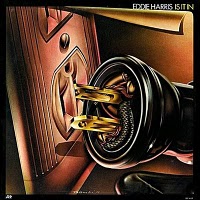 If you dig funk, two words: “Funkaroma” and “Is it In.” (Okay, that’s four words.) “Funkaroma” kicks off the album with Eddie and his plugged in tenor going off on this sixty second intro that just oozes with funky soul. At the one minute mark the band kicks in and funk perfection ensues with everybody firmly on the one. The title track is perfectly realized funk from :01. Guitarist Ronnie Muldrow lays it on thick with this breakneck riff and the band does the rest with Eddie wailing along, electrified, over the top. The drum chant “It’s War” and gooey “Space Commercial” could both easily fit on a 70’s funky Bruton Sound Library LP. Although most of Eddie’s albums from this period are uneven in overall mood and performance (this one is no different), Eddie, his electric sax, and a group of accomplished stateside jam-hounds give funk true meaning with these songs. –A
If you dig funk, two words: “Funkaroma” and “Is it In.” (Okay, that’s four words.) “Funkaroma” kicks off the album with Eddie and his plugged in tenor going off on this sixty second intro that just oozes with funky soul. At the one minute mark the band kicks in and funk perfection ensues with everybody firmly on the one. The title track is perfectly realized funk from :01. Guitarist Ronnie Muldrow lays it on thick with this breakneck riff and the band does the rest with Eddie wailing along, electrified, over the top. The drum chant “It’s War” and gooey “Space Commercial” could both easily fit on a 70’s funky Bruton Sound Library LP. Although most of Eddie’s albums from this period are uneven in overall mood and performance (this one is no different), Eddie, his electric sax, and a group of accomplished stateside jam-hounds give funk true meaning with these songs. –A
Rainbow “Rising” (1976)
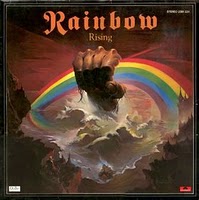 As a blossoming Deep Purple fan ‘Rising’ was my introduction to Ritchie Blackmore’s post-Purple work and although I was initially ambivalent about the sound and Dio’s voice I’ve since come to love this music which, has also helped me appreciate Dio’s stint with Black Sabbath a lot more. After a debut album that fiddled with some of Ritchie Blackmore’s ideas, ‘Rising’ sounds more like a band effort and everything about the sound has got heavier. Dio’s lyrics took me a while to get used to but they sound tailor-made for this kind of dramatic heavy rock and his voice is so good it doesn’t matter matter what is said. The first side of ‘Rising’ is made up of short, punchy heavy rock songs with “Do You Close Your Eyes” being the album’s weakest track and a mood lightener before the album’s two big statements, “Stargazer and “A Light In The Black”. “Stargazer” is a huge undertaking that demands nothing but the best from the people involved. The heavy drone is sustained for eight and a half minutes and Dio’s range is tested in trying to match the constant thunder of the music. “A Light In The Black” is my personal favorite moment of the album, proving that this line-up could rock as hard as anybody. Cozy Powell drives the song along, allowing Dio to swoop and fly vocally, and Tony Carey takes on Ritchie Blackmore in a furious solo battle that brings out the best from both. The album’s a bit short and there isn’t a huge amount of variation but ‘Rising’ contains six good tracks and at least two essentials. –Tom
As a blossoming Deep Purple fan ‘Rising’ was my introduction to Ritchie Blackmore’s post-Purple work and although I was initially ambivalent about the sound and Dio’s voice I’ve since come to love this music which, has also helped me appreciate Dio’s stint with Black Sabbath a lot more. After a debut album that fiddled with some of Ritchie Blackmore’s ideas, ‘Rising’ sounds more like a band effort and everything about the sound has got heavier. Dio’s lyrics took me a while to get used to but they sound tailor-made for this kind of dramatic heavy rock and his voice is so good it doesn’t matter matter what is said. The first side of ‘Rising’ is made up of short, punchy heavy rock songs with “Do You Close Your Eyes” being the album’s weakest track and a mood lightener before the album’s two big statements, “Stargazer and “A Light In The Black”. “Stargazer” is a huge undertaking that demands nothing but the best from the people involved. The heavy drone is sustained for eight and a half minutes and Dio’s range is tested in trying to match the constant thunder of the music. “A Light In The Black” is my personal favorite moment of the album, proving that this line-up could rock as hard as anybody. Cozy Powell drives the song along, allowing Dio to swoop and fly vocally, and Tony Carey takes on Ritchie Blackmore in a furious solo battle that brings out the best from both. The album’s a bit short and there isn’t a huge amount of variation but ‘Rising’ contains six good tracks and at least two essentials. –Tom
My Bloody Valentine “Isn’t Anything” (1988)
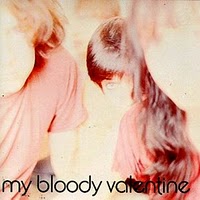 My Bloody Valentine spent a few years wasting time in paisley limbo before growing a massive pair and reinventing psychedelic music as well as a new language for the electric guitar. Isn’t anything is their first full length representation of this, and in my opinion, their greatest achievement as a band. Jesus and Marychain and Spacemen 3 may have peaked before this, as critics love to point out, but who really gives a shit? The Marychain and Spacemen are the dictionary definition of posers, who in the process of riding on America’s musical history for cool points, happened to luck out and make some good music. But there’s nothing original there, no real emotion. Isn’t Anything, on the other hand, is just a total swirling cacophony of electric sounds and emotions; sometimes bending, sometimes stacked on top of each other,sometimes crashing. You realize that this is truly what it feels like to be an opened up human being. It’s the feeling that you’re feeling everything at once and bordering on insanity except that the one connecting point is, no matter what emotions are consuming your senses, they will be extreme. Love, loss, change, it’s all here in it’s purest form, the abstract form. And what’s truely impressive is that the music doesn’t sound dated at all yet it’s blatently psychedellic. The drums and bass border on hardcore via Dinosaur Jr’s mammoth-like approach, while the guitars and vocals, both provided by the heavenly duo of Kevin Sheilds and Belinda Butcher, flow over and consume the sound in a way that the ocean might look lazy but ultimately it couldn’t give a fuck about you and could wipe you out in a second if you were in the way of it’s power. Just throw this on, and make sure it’s at a somewhat loud enough volume. –Alex
My Bloody Valentine spent a few years wasting time in paisley limbo before growing a massive pair and reinventing psychedelic music as well as a new language for the electric guitar. Isn’t anything is their first full length representation of this, and in my opinion, their greatest achievement as a band. Jesus and Marychain and Spacemen 3 may have peaked before this, as critics love to point out, but who really gives a shit? The Marychain and Spacemen are the dictionary definition of posers, who in the process of riding on America’s musical history for cool points, happened to luck out and make some good music. But there’s nothing original there, no real emotion. Isn’t Anything, on the other hand, is just a total swirling cacophony of electric sounds and emotions; sometimes bending, sometimes stacked on top of each other,sometimes crashing. You realize that this is truly what it feels like to be an opened up human being. It’s the feeling that you’re feeling everything at once and bordering on insanity except that the one connecting point is, no matter what emotions are consuming your senses, they will be extreme. Love, loss, change, it’s all here in it’s purest form, the abstract form. And what’s truely impressive is that the music doesn’t sound dated at all yet it’s blatently psychedellic. The drums and bass border on hardcore via Dinosaur Jr’s mammoth-like approach, while the guitars and vocals, both provided by the heavenly duo of Kevin Sheilds and Belinda Butcher, flow over and consume the sound in a way that the ocean might look lazy but ultimately it couldn’t give a fuck about you and could wipe you out in a second if you were in the way of it’s power. Just throw this on, and make sure it’s at a somewhat loud enough volume. –Alex
Pink Floyd “Atom Heart Mother” (1970)
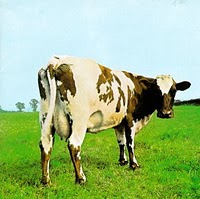 This is a hard Pink Floyd album, even the band admits it was an unwise “concept” idea. Side one, the “Atom Heart Mother Suite” marries orchestration with Floyd’s ethereal wisps of other worldliness, but…it didn’t quite turn out. The AHM is not quite a convincing mesh of band and orchestra as the band and orchestra play around each other, not together. To me, the issue is AHM really acts more as a traditional score/soundtrack rather than a Floyd contemporary reinvention of soundtrack soundscapes into what should have been a major prog opus, but…it needed more (no pun!!). That said convoluted as it’s concept and execution, to my ears, some bits did work out, side two…Summer ’68, Alan’s Psychedelic Breakfast…are all sublime slow burners. It’s a record you need to have if you dig seventies era Floyd at all, for experience, it’s a sweet struggle to hear the Floyd moving past Gilmour’s recreation of the world Syd Barrett invented. –Nipper
This is a hard Pink Floyd album, even the band admits it was an unwise “concept” idea. Side one, the “Atom Heart Mother Suite” marries orchestration with Floyd’s ethereal wisps of other worldliness, but…it didn’t quite turn out. The AHM is not quite a convincing mesh of band and orchestra as the band and orchestra play around each other, not together. To me, the issue is AHM really acts more as a traditional score/soundtrack rather than a Floyd contemporary reinvention of soundtrack soundscapes into what should have been a major prog opus, but…it needed more (no pun!!). That said convoluted as it’s concept and execution, to my ears, some bits did work out, side two…Summer ’68, Alan’s Psychedelic Breakfast…are all sublime slow burners. It’s a record you need to have if you dig seventies era Floyd at all, for experience, it’s a sweet struggle to hear the Floyd moving past Gilmour’s recreation of the world Syd Barrett invented. –Nipper
Crazy Horse “At Crooked Lake” (1972)
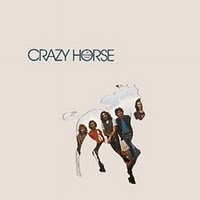 I love this record, it skillfully straddles country rock and (something like) power pop without sounding contrived. The songs are uplifting, driving, downright sweet and packed full of harmonies…the album is worth it alone for the lead track “Rock and Roll Band”! And, honestly, for all the Neil Young and Crazy Horse collaborations considered canon, I’d play this before any Neil Young (and Crazy Horse) record. Take a second to swallow/regain your composure…I KNOW, right!? Don’t hate me…but…it’s true!! Crooked Lake is that good. Unfortunately, with member Danny Whitten locked into a downward spiral of booze and pills, from which he would die soon after, this was the last of Crazy Horses LPs before they faded back into their other bands for a bit…Nils Lofgren back to Grin, Nitzsche, back in to production work…and the other core Crazies back with Mr. Young. Crazy Horse wouldn’t reassemble, without Young, until 1978’s Crazy Moon. –Nipper
I love this record, it skillfully straddles country rock and (something like) power pop without sounding contrived. The songs are uplifting, driving, downright sweet and packed full of harmonies…the album is worth it alone for the lead track “Rock and Roll Band”! And, honestly, for all the Neil Young and Crazy Horse collaborations considered canon, I’d play this before any Neil Young (and Crazy Horse) record. Take a second to swallow/regain your composure…I KNOW, right!? Don’t hate me…but…it’s true!! Crooked Lake is that good. Unfortunately, with member Danny Whitten locked into a downward spiral of booze and pills, from which he would die soon after, this was the last of Crazy Horses LPs before they faded back into their other bands for a bit…Nils Lofgren back to Grin, Nitzsche, back in to production work…and the other core Crazies back with Mr. Young. Crazy Horse wouldn’t reassemble, without Young, until 1978’s Crazy Moon. –Nipper
Emmylou Harris “Elite Hotel” (1975)
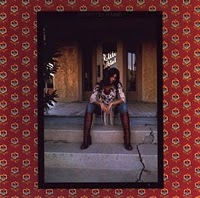 Great interpretations of classic country and rock songs by the rare singer who’s voice matches up to her physical beauty. Backed by the excellent Hot Band, Emmylou exudes a sort of dewy innocence, even when singing world-weary songs of heartache and drinking. It makes the sadness all the more palpable, because you want such purity sheltered from the evils of the world. –Lucas
Great interpretations of classic country and rock songs by the rare singer who’s voice matches up to her physical beauty. Backed by the excellent Hot Band, Emmylou exudes a sort of dewy innocence, even when singing world-weary songs of heartache and drinking. It makes the sadness all the more palpable, because you want such purity sheltered from the evils of the world. –Lucas
Big Star “#1 Record” (1972)
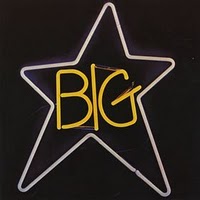 A shimmering, exciting record that captures pop’s innocence, hints at rock’s degradation, and mines melody for all it’s worth, this is the gold standard by which all so-called power pop would be measured. The only group I know of to convincingly meld the Beatles, Byrds, and Rolling Stones to create something wholly new, this has been worshipped by hipsters for years and influenced countless great bands… but in a just world, the three original Big Star albums would be at least as famous as the aforementioned bands’ classics. Perhaps it’s just too skewed to register in the popular psyche. The harmonies are unconventional, the guitar attack hard but never wanky, the ballads emotionally complex.
A shimmering, exciting record that captures pop’s innocence, hints at rock’s degradation, and mines melody for all it’s worth, this is the gold standard by which all so-called power pop would be measured. The only group I know of to convincingly meld the Beatles, Byrds, and Rolling Stones to create something wholly new, this has been worshipped by hipsters for years and influenced countless great bands… but in a just world, the three original Big Star albums would be at least as famous as the aforementioned bands’ classics. Perhaps it’s just too skewed to register in the popular psyche. The harmonies are unconventional, the guitar attack hard but never wanky, the ballads emotionally complex.
Big Star’s Alex Chilton and Chris Bell were music lovers above all, and wrote music that celebrates itself above all. Each song is distinct, filled out to the appropriate shape, never overstepping and never failing to follow a hook where it might go. It’s the kind of debut album most groups would kill to have for a career’s greatest hits package. –Will
R.I.P. Alex Chilton (1950-2010)
Gene Harris “Astral Signal” (1974)
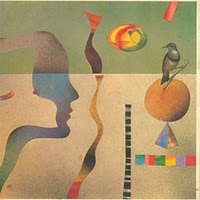 Gene Harris really did come into himself when he ditched the Three Sounds and went into the ‘70s with full electronic funkiness. Side one of this album is mostly taken up with a medley of tunes that start with a psyched out “Prelude”, then moves through a hypnotically beautiful tribute to summer (“Summer (the First Time)”, Rebato Summer” and “I Remember Summer”), then once your all tripped out it kicks into the most incredibly dirty and heavy version of “Don’t Call Me Nigger Whitey” that will literally take your breath away. After the first gap on the side you get the killer rare-groove gem “Losalamitoslatinfunklovesong”, and even though this is on loads of compilations you still can’t beat hearing it in its original setting. Lastly you get the only straight jazz tune on the side, the solo piano piece “My Roots”. Side two is a little more subdued, but still no less amazing. You get the Harvey Mason composed/arranged “Higga-Boom” on this side, which though I’m not too mad on, still can’t deny its amazing driving groove. This album really is a jazz-funk/fusion masterpiece, definitely one of the most amazing finds I’ve come across in recent digs. –Nick
Gene Harris really did come into himself when he ditched the Three Sounds and went into the ‘70s with full electronic funkiness. Side one of this album is mostly taken up with a medley of tunes that start with a psyched out “Prelude”, then moves through a hypnotically beautiful tribute to summer (“Summer (the First Time)”, Rebato Summer” and “I Remember Summer”), then once your all tripped out it kicks into the most incredibly dirty and heavy version of “Don’t Call Me Nigger Whitey” that will literally take your breath away. After the first gap on the side you get the killer rare-groove gem “Losalamitoslatinfunklovesong”, and even though this is on loads of compilations you still can’t beat hearing it in its original setting. Lastly you get the only straight jazz tune on the side, the solo piano piece “My Roots”. Side two is a little more subdued, but still no less amazing. You get the Harvey Mason composed/arranged “Higga-Boom” on this side, which though I’m not too mad on, still can’t deny its amazing driving groove. This album really is a jazz-funk/fusion masterpiece, definitely one of the most amazing finds I’ve come across in recent digs. –Nick
Soft Machine “Volume Two” (1969)
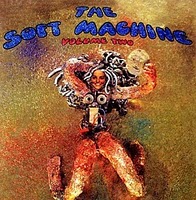 My personal favorite entry in the Soft Machine catalog, Volume 2 perfectly balances the psychedelia of their debut with the jazz-rock leanings of follow up Third. Sporting a stoner-friendly, reverb-drenched production, Wyatt’s vocals are as expressive as ever, with his drum prowess underscoring the tragedy of his paralysis a few years later, while Ratledge is favoring thick acoustic piano chords as much, if not more than, organ. Kevin Ayers is gone and in his place we have Hugh Hopper filling in the bass seat, decidedly more nimble-fingered and with his oft used fuzz pedal in tow, not to mention brother Brian on sax. Like their first album, side one consists of a suite of sorts, something of a cut and paste job that nevertheless keeps things going with highlights like the Third predicting sax driven “Hibou Anemone And Bear”, and “Dada Was Here” with Wyatt’s passionate yet nonsensical vocal delivery. Side two tends to follow a more conventional arrangement of separate songs, favorites being the twisted acoustic “Dedicated To You But You Weren’t Listening”, “Pig” with it’s heavy fuzz-bass intro, and “10:30 Returns To The Bedroom” closing the album with some rapid fire fusion, and closing the door on Soft Machine’s pysch days for the jazzier pursuits to come. Volume 2 is one of those “difficult” albums that nevertheless draws one back continually, melodic content complex yet somehow totally captivating, instrumental aptitude in bounds, but focused for ultimate effect. –Ben
My personal favorite entry in the Soft Machine catalog, Volume 2 perfectly balances the psychedelia of their debut with the jazz-rock leanings of follow up Third. Sporting a stoner-friendly, reverb-drenched production, Wyatt’s vocals are as expressive as ever, with his drum prowess underscoring the tragedy of his paralysis a few years later, while Ratledge is favoring thick acoustic piano chords as much, if not more than, organ. Kevin Ayers is gone and in his place we have Hugh Hopper filling in the bass seat, decidedly more nimble-fingered and with his oft used fuzz pedal in tow, not to mention brother Brian on sax. Like their first album, side one consists of a suite of sorts, something of a cut and paste job that nevertheless keeps things going with highlights like the Third predicting sax driven “Hibou Anemone And Bear”, and “Dada Was Here” with Wyatt’s passionate yet nonsensical vocal delivery. Side two tends to follow a more conventional arrangement of separate songs, favorites being the twisted acoustic “Dedicated To You But You Weren’t Listening”, “Pig” with it’s heavy fuzz-bass intro, and “10:30 Returns To The Bedroom” closing the album with some rapid fire fusion, and closing the door on Soft Machine’s pysch days for the jazzier pursuits to come. Volume 2 is one of those “difficult” albums that nevertheless draws one back continually, melodic content complex yet somehow totally captivating, instrumental aptitude in bounds, but focused for ultimate effect. –Ben
Ramones “Ramones” (1976)
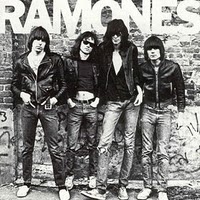 My Ramones story goes — I couldn’t have been more than sixteen years old when I took a trip to the Big Apple with my family during the Thanksgiving holidays. I had been to the city several times before, but this trip was different: my interest in music had grown, I was aware of such a place as CBGB’s, and I had a somewhat understanding of the late 70’s punk movement. My knowledge on the topic was green, but anyhoo – I knew the basics. I would be lying if I said I listened to the music of the Ramones before, but if you were to ask, most likely I would have shrugged my shoulders in agreement that, “yes, I’ve listened to the Ramones.” I even had my very on Ramones t-shirt, despite never hearing any slab of music outside the “Hey Ho” chant of “Blitzkrieg Bop.” As music lovers, we all have been there – loving a band just for the sake of loving them. It could be an older sibling introducing what’s hip or simply idealizing a group to the point of feeling obligations to seek out their influences. For me, it was simpler than that. I saw a Ramones seal t-shirt in a window store and had to have it. Not the coolest introduction, but hey – I’m being honest. That was two years prior. Which brings us back to the New York City-Thanksgiving-Family-Vacation. As I mentioned before my knowledge in music had expanded. Therefore, one of the first things on ‘my’ to-do-list was seek out the nearest record store. My dad got the information from the concierge desk. The rest of the family went shopping with a plan to meet back up around lunch. The record store we found was not some stylish ‘mom & pop’ underground glory, but a mega-store that could have very well been Best Buy or Virgin, can’t exactly remember, it was a long time ago. I just remember it being big. The ‘cool’ meter from this story is already a scorcher, I know. But, like I said — I’m being honest. My pops gave me ample time to look around and peruse the album titles. Soon after it became apparent, why not pick up a Ramones album? Already have the shirt, why not get the music. I of course selected their debut, and it wasn’t because I knew it was the first or cos the only song I recognized was, “Blitzkrieg Bop.” Truth be told, it was the artwork that made my decision. Johnny Ramone, so discreetly, giving the middle finger and Tommy, doing his best to add inches to his undersized height, standing on all tippy toes. While Joey, looking frail and freakish, towering over all his bandmates and Dee Dee…well, just being Dee Dee. The artwork was piercing, with its hoary set color, giving the appearance of an already classic album, I knew I had found my purchase. Many label this band as ‘dumb.’ But that doesn’t really fit. No dumbass I know could ever be described as an inventor of a revolution. Granted, these guys weren’t rocket scientists, they still possessed a talent which sparked an excitement that had been absent from rock. Back to the basics – that was their mission. And it’s obvious they had some wit. If not, they wouldn’t have been able to knock out four classic albums back-to-back, from their debut on to Road to Ruin. And even after, they still showed signs of luster with the Phil Spector produced, End of the Century, plus 1984’s, Too Tough To Die. There was consistency, no question. What gets me about their debut, above all the rest, is it never lets up. 14 songs in under 30 minutes. Now, that’s blitzing. No bullshit. No in between. Just plain old fashioned rock ‘n’ roll without all the self-indulgence that suffocated it from previous years. If I’m not a guitar player, then how the hell am I going to appreciate some fifteen minute virtuoso guitar solo? How am I suppose to relate? And more importantly, value what I’m hearing? The Ramones got that. And that’s what they unleashed on the world in 1976. I love the fact I was in New York the day I first listened to the Ramones. I love how I was experiencing their music in the very city that shaped their sound. I love how I could be passing 53rd and 3rd in a cab while hearing Dee Dee singing about turning tricks. I love hearing songs about chainsaws, beating on brats, and punks named, Judy. The Ramones first album was my New York City experience at the time. It made me see the city in a whole new light. Later I would move to NYC after my 22nd birthday and have other albums play there part in my living and musical advancements. But the Ramones were the first, and it’s fitting, seeing as they were the first to do everything back then. –Jason
My Ramones story goes — I couldn’t have been more than sixteen years old when I took a trip to the Big Apple with my family during the Thanksgiving holidays. I had been to the city several times before, but this trip was different: my interest in music had grown, I was aware of such a place as CBGB’s, and I had a somewhat understanding of the late 70’s punk movement. My knowledge on the topic was green, but anyhoo – I knew the basics. I would be lying if I said I listened to the music of the Ramones before, but if you were to ask, most likely I would have shrugged my shoulders in agreement that, “yes, I’ve listened to the Ramones.” I even had my very on Ramones t-shirt, despite never hearing any slab of music outside the “Hey Ho” chant of “Blitzkrieg Bop.” As music lovers, we all have been there – loving a band just for the sake of loving them. It could be an older sibling introducing what’s hip or simply idealizing a group to the point of feeling obligations to seek out their influences. For me, it was simpler than that. I saw a Ramones seal t-shirt in a window store and had to have it. Not the coolest introduction, but hey – I’m being honest. That was two years prior. Which brings us back to the New York City-Thanksgiving-Family-Vacation. As I mentioned before my knowledge in music had expanded. Therefore, one of the first things on ‘my’ to-do-list was seek out the nearest record store. My dad got the information from the concierge desk. The rest of the family went shopping with a plan to meet back up around lunch. The record store we found was not some stylish ‘mom & pop’ underground glory, but a mega-store that could have very well been Best Buy or Virgin, can’t exactly remember, it was a long time ago. I just remember it being big. The ‘cool’ meter from this story is already a scorcher, I know. But, like I said — I’m being honest. My pops gave me ample time to look around and peruse the album titles. Soon after it became apparent, why not pick up a Ramones album? Already have the shirt, why not get the music. I of course selected their debut, and it wasn’t because I knew it was the first or cos the only song I recognized was, “Blitzkrieg Bop.” Truth be told, it was the artwork that made my decision. Johnny Ramone, so discreetly, giving the middle finger and Tommy, doing his best to add inches to his undersized height, standing on all tippy toes. While Joey, looking frail and freakish, towering over all his bandmates and Dee Dee…well, just being Dee Dee. The artwork was piercing, with its hoary set color, giving the appearance of an already classic album, I knew I had found my purchase. Many label this band as ‘dumb.’ But that doesn’t really fit. No dumbass I know could ever be described as an inventor of a revolution. Granted, these guys weren’t rocket scientists, they still possessed a talent which sparked an excitement that had been absent from rock. Back to the basics – that was their mission. And it’s obvious they had some wit. If not, they wouldn’t have been able to knock out four classic albums back-to-back, from their debut on to Road to Ruin. And even after, they still showed signs of luster with the Phil Spector produced, End of the Century, plus 1984’s, Too Tough To Die. There was consistency, no question. What gets me about their debut, above all the rest, is it never lets up. 14 songs in under 30 minutes. Now, that’s blitzing. No bullshit. No in between. Just plain old fashioned rock ‘n’ roll without all the self-indulgence that suffocated it from previous years. If I’m not a guitar player, then how the hell am I going to appreciate some fifteen minute virtuoso guitar solo? How am I suppose to relate? And more importantly, value what I’m hearing? The Ramones got that. And that’s what they unleashed on the world in 1976. I love the fact I was in New York the day I first listened to the Ramones. I love how I was experiencing their music in the very city that shaped their sound. I love how I could be passing 53rd and 3rd in a cab while hearing Dee Dee singing about turning tricks. I love hearing songs about chainsaws, beating on brats, and punks named, Judy. The Ramones first album was my New York City experience at the time. It made me see the city in a whole new light. Later I would move to NYC after my 22nd birthday and have other albums play there part in my living and musical advancements. But the Ramones were the first, and it’s fitting, seeing as they were the first to do everything back then. –Jason
Led Zeppelin “Presence” (1976)
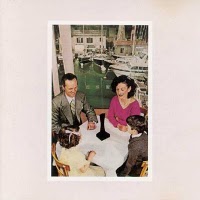 One of Led Zeppelin’s greatest strengths was their willingness to explore and evolve, despite potential monetary incentive to put out more of the same. So, in 1976 we get Presence, with its harder grooves and choppy, funky guitar licks and not too much psychedelic blues wandering (“Tea for One” excepted) or acoustic folk-rock. Whether you consider this evolution welcome or not, it was certainly organic, and it resulted in the release of two flat-out, epic masterpieces. “Nobody’s Fault But Mine” follows in the time-honored tradition of Led Zeppelin copping a song that pre-dates them by decades, and transforming it into something so majestic (and bombastic) that it practically renders all previous versions inert by comparison. “Achilles Last Stand” is something else entirely. It may be the best ten-minute track ever recorded. It’s certainly in the top three in Zeppelin’s discography. Blistering, intense and mind-blowing; think Rush on steroids. So, when viewed as a whole, Presence holds up a lot better than its reputation would suggest. –Lucas
One of Led Zeppelin’s greatest strengths was their willingness to explore and evolve, despite potential monetary incentive to put out more of the same. So, in 1976 we get Presence, with its harder grooves and choppy, funky guitar licks and not too much psychedelic blues wandering (“Tea for One” excepted) or acoustic folk-rock. Whether you consider this evolution welcome or not, it was certainly organic, and it resulted in the release of two flat-out, epic masterpieces. “Nobody’s Fault But Mine” follows in the time-honored tradition of Led Zeppelin copping a song that pre-dates them by decades, and transforming it into something so majestic (and bombastic) that it practically renders all previous versions inert by comparison. “Achilles Last Stand” is something else entirely. It may be the best ten-minute track ever recorded. It’s certainly in the top three in Zeppelin’s discography. Blistering, intense and mind-blowing; think Rush on steroids. So, when viewed as a whole, Presence holds up a lot better than its reputation would suggest. –Lucas


